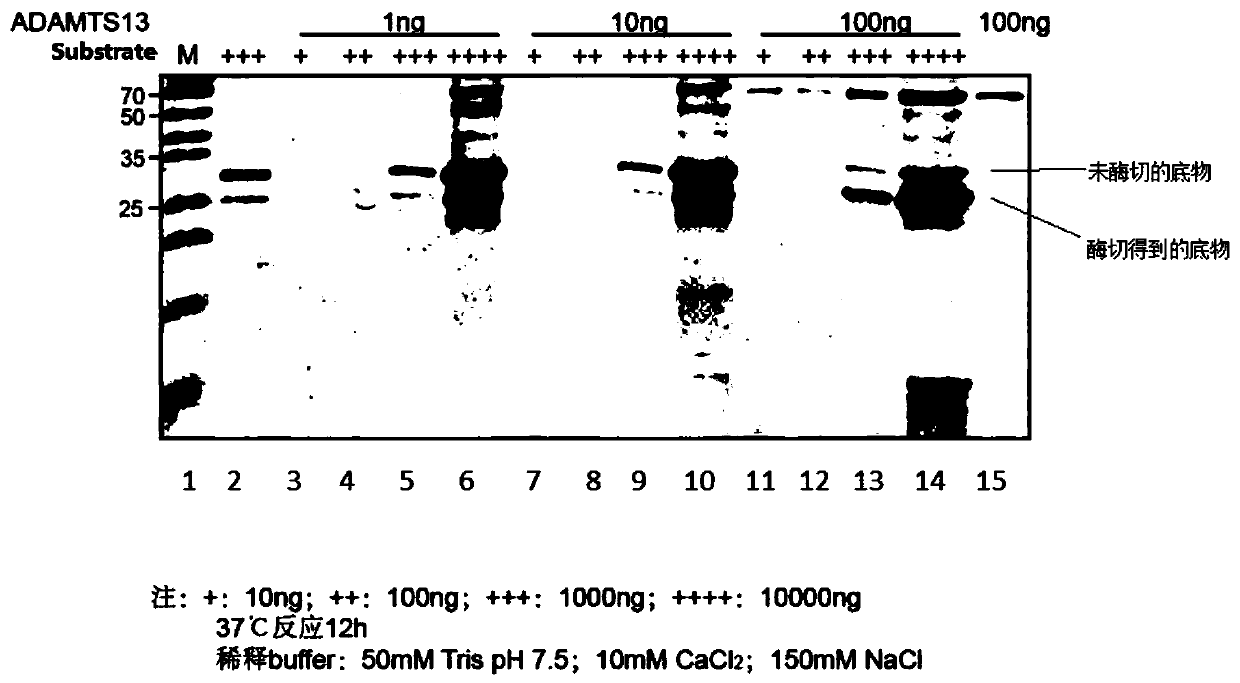ADAMTS13 substrate with histidine tags and preparation method and application of ADAMTS13 substrate
A histidine tag and substrate technology, applied in the field of molecular cloning of biotechnology, can solve the problems of high cost of chemically synthesized substrates, affecting disease judgment, and the impact of patient sample color detection results, etc., to achieve cost reduction, guaranteed yield, cost reduction effect
- Summary
- Abstract
- Description
- Claims
- Application Information
AI Technical Summary
Problems solved by technology
Method used
Image
Examples
Embodiment 1
[0035] 1. Construction of expression plasmid pGEX6p-1-vWF73-6His
[0036] 1) The primer sequences used for the PCR reaction are shown in Table 1 below:
[0037] Table 1 Primer sequences for PCR reactions
[0038]
[0039] PCR reaction system:
[0040] 2.5uL each of 1uM primers, 10ng cDNA 1uL, 45uL PCR mix (Invitrogen 10572-014).
[0041] 2) The PCR reaction uses cDNA as the reaction template, denatures at 94°C for 30 seconds, anneals at 50°C for 30 seconds, extends at 72°C for 30 seconds, and terminates the reaction after 40 cycles of reaction;
[0042]3) After the PCR product is gel-cut and purified, carry out BamHI and EcoRI double enzyme digestion reactions, and simultaneously perform double enzyme digestion reactions on the expression vector pGEX6p-1, and bathe in water at 37°C for 4 hours;
[0043] 4) Purify the enzyme-digested PCR products and plasmids. After the DNA concentration is determined, mix the PCR products and carrier plasmids at a molar ratio of 5:1, add...
Embodiment 2
[0046] Expression and Purification of Substrate Protein GST-vWF73-6His
[0047] 1) Transfect and express the bacterial strain BL21, and incubate at 37°C for 24 hours on an LB agarose plate containing 100ug / ml;
[0048] 2) Select 2-3 clones and culture them with a small dose of about 5ml of LB culture medium, until the absorbance value OD600 reaches about 0.5, add IPTG to 1mM, and continue to culture with shaking at 37 degrees for 2 hours;
[0049] 3) Collect the cells, heat and lyse them, and use the anti-GST antibody to do western blot to verify positive expression clones by SDS-PAGE electrophoresis;
[0050] 4) Save positive expression clones;
[0051] 5) The positive clones were cultured in large volume and induced to express. After the bacteria were collected, lysozyme was added and ultrasonically lysed, and the supernatant was collected after high-speed centrifugation at 4°C;
[0052] 6) Firstly, it was purified by Glutathione Sepharose 4B affinity column, and then the ...
Embodiment 3
[0059] Identification of Substrate Protein GST-vWF73-6His by Digestion in Vitro
[0060] with 10mM CaCl 2 , 150mM NaCl, 50mM Tris, the buffer solution of pH7.5 dilute the substrate protein GST-vWF73-6His prepared in Example 2, and dilute to 10ng, 100ng, 1000ng and 10000ng respectively, and then respectively and different amounts (1ng, 10ng, 100ng ) of ADAMTS13 was incubated at 37°C for 12 hours, and after SDS-PAGE gel electrophoresis, the digestion effect was detected with GST antibody, and the detection results were as follows figure 1 shown by figure 1 Comparative analysis of the results showed that 100ng of ADAMTS13 could efficiently digest 10ug of GST-vWF73-6His substrate protein, lane 2 was 100ng of substrate protein GST-vWF73-6His, and lane 15 was 100ng of ADAMTS13.
PUM
 Login to View More
Login to View More Abstract
Description
Claims
Application Information
 Login to View More
Login to View More - R&D
- Intellectual Property
- Life Sciences
- Materials
- Tech Scout
- Unparalleled Data Quality
- Higher Quality Content
- 60% Fewer Hallucinations
Browse by: Latest US Patents, China's latest patents, Technical Efficacy Thesaurus, Application Domain, Technology Topic, Popular Technical Reports.
© 2025 PatSnap. All rights reserved.Legal|Privacy policy|Modern Slavery Act Transparency Statement|Sitemap|About US| Contact US: help@patsnap.com



